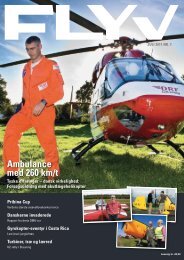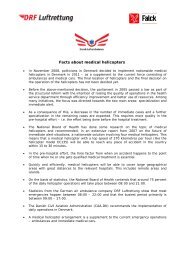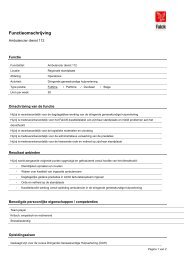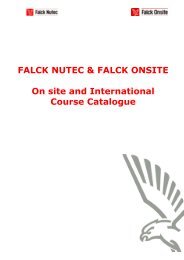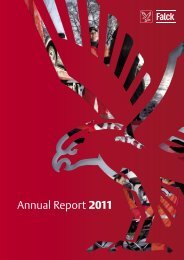Annual Report 2010 - Falck
Annual Report 2010 - Falck
Annual Report 2010 - Falck
Create successful ePaper yourself
Turn your PDF publications into a flip-book with our unique Google optimized e-Paper software.
64 <strong>Falck</strong> <strong>Annual</strong> <strong>Report</strong> <strong>2010</strong> | Group<br />
Notes to the Group financial statements<br />
Note<br />
1 Accounting policies (continued)<br />
Other non-current employee benefits are similarly recognised<br />
based on an actuarial calculation. All actuarial gains and losses<br />
are recognised immediately in the income statement, however.<br />
Other non-current employee obligations include jubilee<br />
bonuses and non-current severance schemes.<br />
Provisions<br />
Provisions are recognised when, as a consequence of an event<br />
occurring before or on the balance sheet date, the Group has<br />
a legal or constructive obligation and it is probable that an<br />
outflow of resources will be required to settle the obligation.<br />
Provisions for restructuring are recognised when a detailed,<br />
formal plan for the restructuring has been made before or<br />
on the balance sheet date and has been announced to the<br />
parties involved. In connection with acquisitions, provisions<br />
for restructuring costs are only included in the computation of<br />
goodwill if an obligation exists for the entity acquired as of the<br />
date of acquisition.<br />
Provisions are made for onerous contracts when the anticipated<br />
benefits to the Group from a contract are outweighed<br />
by the unavoidable costs under the contract.<br />
When the Group is under an obligation to dismantle an asset<br />
or re-establish the site where the asset has been used, a<br />
provision is made corresponding to the present value of the<br />
expected future costs. The provision is determined based on<br />
current orders and estimated future costs, discounted to their<br />
present value. The discount factor used reflects the general<br />
level of interest rates. The present value of the costs is recognised<br />
in the cost of the item of property, plant and equipment<br />
in question and depreciated with these assets. The increase of<br />
the present value over time is recognised in the income statement<br />
under financial expenses.<br />
Financial liabilities<br />
Debt to credit institutions is recognised at the raising of a loan<br />
as the proceeds received less transaction costs. In subsequent<br />
periods, financial liabilities are measured at amortised cost.<br />
Residual lease commitments from finance leases are recognised<br />
at amortised cost.<br />
Other financial liabilities are measured at amortised cost.<br />
Deferred income<br />
Deferred income primarily represents subscription revenue<br />
relating to several financial periods.<br />
LEASING<br />
For financial reporting purposes, lease liabilities are classified<br />
as either finance or operating lease liabilities.<br />
Leases are classified as finance leases when substantially all<br />
risks and rewards of ownership of the leased asset are transferred.<br />
Other leases are classified as operating leases.<br />
The accounting treatment of assets held under finance lease<br />
and the related liability is described in the sections on property,<br />
plant and equipment and financial liabilities, respectively.<br />
Assets held under operating leases are not recognised in the<br />
balance sheet. Lease liabilities under operating leases are<br />
disclosed as contingent liabilities.<br />
Lease payments concerning operating leases are recognised in<br />
the income statement on a straight-line basis over the term of<br />
the lease.<br />
CASH FLOW STATEmENT<br />
The cash flow statement is presented according to the indirect<br />
method and shows the cash flow from operating activities, the<br />
cash flow from investing activities, the cash flow from financing<br />
activities and cash and securities at the beginning and end<br />
of the year.<br />
The cash flow statement includes cash flows from companies<br />
acquired as from the date of acquisition, and cash flows from<br />
companies divested until the date of divestment.<br />
Cash flow from operating activities<br />
Cash flows from operating activities include revenue less<br />
operating expenses adjusted for non-cash operating items and<br />
changes in working capital.<br />
Cash flows from operating activities are adjusted for cash<br />
flows related to exceptional items and corporation tax.<br />
Cash flow from investing activities<br />
Cash flows from investing activities include cash flows from<br />
the acquisition and divestment of companies, non-controlling<br />
interests and operations and the purchase and sale of<br />
intangible assets, property, plant and equipment and other<br />
non-current assets and the purchase and sale of securities not<br />
included in cash and cash equivalents.<br />
Entering into a finance lease is considered a non-cash transaction.



